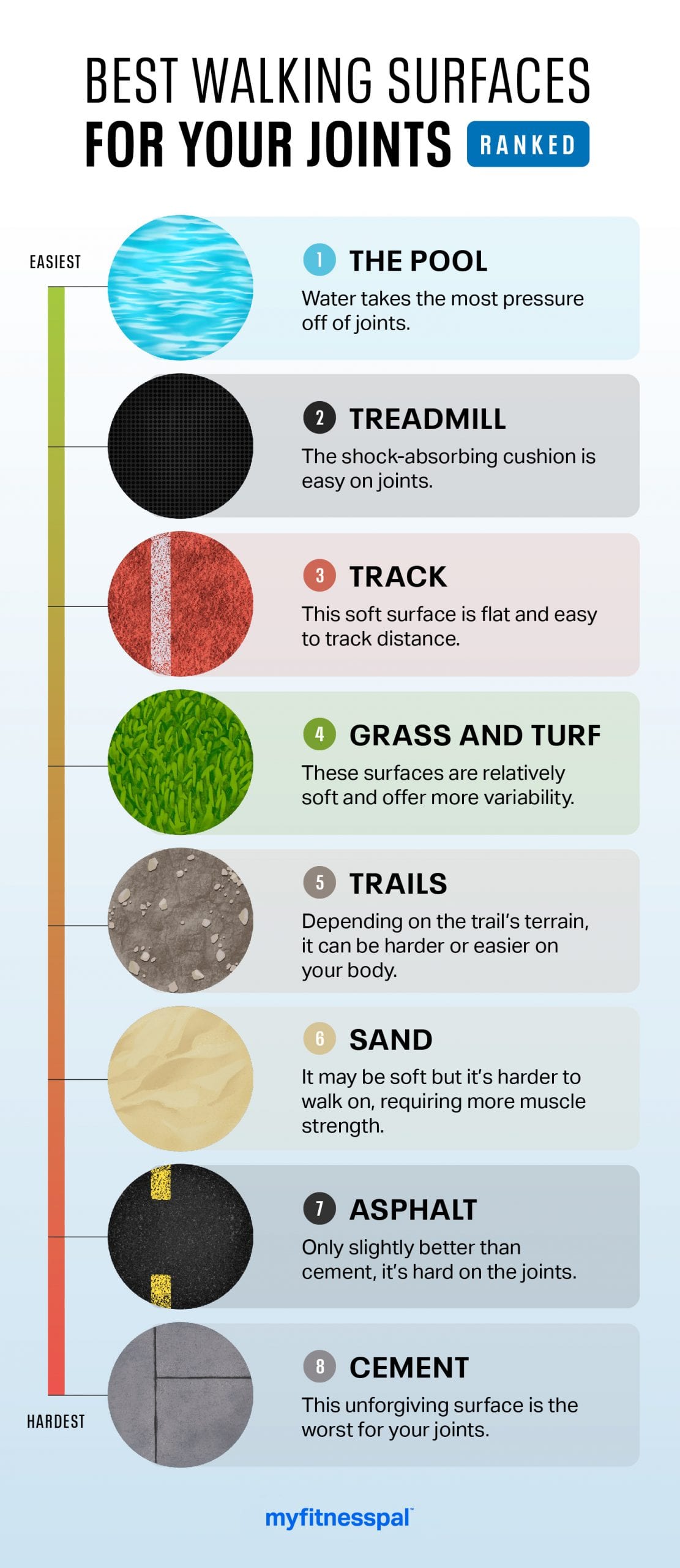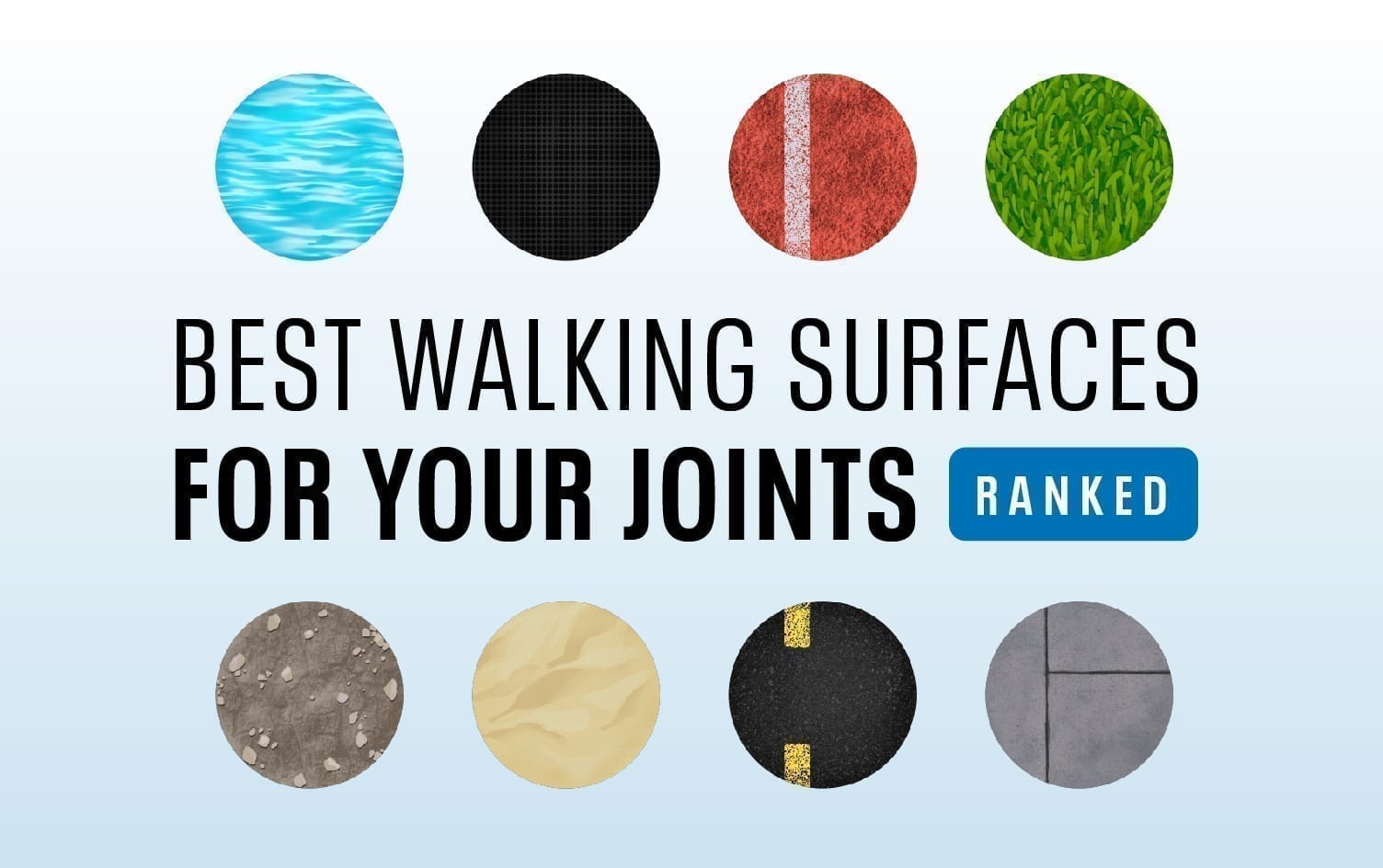One of the best things about walking is you can do it anywhere, anytime making a workout accessible no matter where you go. But, any experienced walker knows not all walking surfaces are created equal where your joints are concerned.
When it comes to choosing where you’ll walk, you want to consider both terrain and texture, says Katy Bowman, MS, a biomechanist and co-creator of Walking Well. “The degree of incline or decline would be an example of terrain, and bumps are examples of texture,” she explains. ”Each combination of these moves uses different muscles.”
Overall, it’s a good idea to switch up your walking surfaces to get the most well-rounded body you can and prevent injury. “Just like being a good musician means being able to play lots of different pieces of music, a robust walker can cover many different textures and terrains,” says Bowman.
Naturally, all walking surfaces have their pros and cons, but some are certainly easier on your body for everyday walking than others. Experts rank the most common surfaces from best to worst for varied workouts and keeping your joints healthy, along with what you need to know about each to make the most of your walks.

THE POOL
Pool walking ranks high among walking experts for its pros. “There are so many benefits of pool walking in helping someone meet their fitness goals, improve balance and gain body/joint range of motion,” says Donna Robertson, a teaching consultant for Foot Solutions and a board-certified pedorthist. This is partially due to the resistance water provides during movement, as well as buoyancy, which can aid in restoring postural balance while taking pressure off the joints.
The only downside here is the convenience factor. Some may not have access to a pool or may not feel like suiting up to get in the water. But experts agree it’s well worth the trouble.
TREADMILL
There are many advantages to walking on a treadmill. “For those who are just beginning, or for those who are experiencing joint pain or are a little shaky on their feet, the best surface for you is the treadmill,” says Graca. “You have control over both your speed and intensity, and you can set a pace and incline you’re comfortable with.” Graca also points out that treadmills have rails you can grab onto if you’re feeling shaky or need support during your walk (although you shouldn’t get into the habit of doing so if you’re looking to maximize your calorie burn). Treadmills also have shock-absorbing technology, meaning your workout is lower-impact, and they allow you to get your walk in no matter the weather.
In terms of downsides, there are a couple. “Because of the propulsion of the treadmill belt, the machine is doing some of the work for you,” Taylor explains. “You may not be using all of your muscles to full capacity.” This can also affect your heel strike, she says, which may lead to knee problems for some people. Treadmills can also feel monotonous, and you might be less motivated to push yourself.
TRACK
A track is a softer surface and therefore lower-impact on joints. “It’s an easy way to bust out some miles,” Bowman adds, especially since the standard track distance makes it simple to measure how far you’ve walked.
The cons, according to Bowman, are that depending on where your local track is, it may not always be available on school days, and tracks are very flat, so you don’t have the opportunity to vary your incline.
GRASS AND TURF
“The pro of grass and turf is that this surface offers some degree of variability,” says Bowman. Because it’s a relatively soft surface, you’ll have to work slightly harder than you would otherwise, and it’s easier on your joints.
In terms of downsides, most grass and turf fields are flat, so you may miss out on the benefits of walking hills, Bowman points out. Grass may also be a poor choice for people who have balance issues or weak ankles due to the uneven surface. “Also note that if grass is wet, it can
become slippery,” Taylor adds, which might increase risk of injury.
TRAILS
“Trails are a natural surface that offer a high degree of variability, which can result in more body use,” says Bowman. Essentially, when your surface is varied, your body works harder. One study found walking on a surface that varied by only 2.5 cm (1 inch) from a flat smooth one resulted in an extra 28% increase in calorie-burning, adds Sarah Pelc Graca, a certified personal trainer.
“Plus, nature comes with its own nutrients,” Bowman says. The benefits of getting out in nature for your walk include lower stress levels, more energy and, often, a more intense workout. You can find trails suitable for all fitness levels, and it’s a great way to explore new areas to help you stay motivated.
Of course, all walking surfaces have their drawbacks, and trails are no exception. Some people may need to drive long distances to get to a trail, and weather might restrict your options. Also, because trails are likely to have a mixture of dirt, rocks and other materials, it’s important to stay alert about where you’re stepping to avoid injury.
SAND
If you’ve ever gone for a stroll on the beach, you probably know how challenging walking in sand can be. “Walking through soft sand requires a lot more muscle strength and activation, resulting in quicker fatigue compared to walking on flat stable surfaces,” says Robertson. If you’re trying to get a quick workout, this can be a major advantage. Pro tip: If you’re walking on a beach, the sand furthest from the water will be driest and softest, and therefore most challenging to walk on.
On the flip side, the soft quality of sand can lead to injuries and strains, especially if you always walk barefoot, Robertson says. If you’re walking on the beach, it’s also important to keep the natural tilt of the terrain in mind, says Taylor. If you always walk in one direction, you may be getting an uneven workout, so it’s best to split your walk by walking in one direction, then turning around and walking in the opposite direction to balance things out.
ASPHALT
Asphalt is a slightly better option than cement sidewalks, since it’s a bit more forgiving, Taylor says. It also has the benefit of being a smooth, even surface, provided the asphalt is in good condition.
However, it’s still on the firmer side, which means it can be harsh on joints over time, especially if you tend to walk long distances.
CEMENT
Cement sidewalks are generally flat and widely accessible, which can be helpful for people who have trouble with balance or are looking to go outside for a short walk.
The problem is “sidewalks made of cement have no elasticity,” says Jo Ann Taylor, co-founder and owner of The Walking Connection. “If you have joint issues, this can put undue stress on the knees, ankles and hips,” she says, especially if you walk on this surface regularly. If it can’t be avoided, she recommends making sure your shoes have proper cushioning.
To become more active, try setting a simple goal to increase (and track) your daily steps. Go to “Plans” in the MyFitnessPal app and choose a 28-day step plan to learn tips to boost your activity.




